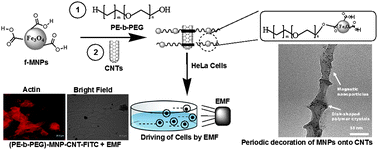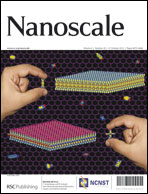We describe here the success of an innovative approach of direct immobilization of magnetic nanoparticles (MNPs) onto carbon nanotubes (CNTs). The approach involved functionalization of magnetic nanoparticles and consequent covalent linkage to a copolymer (PE-b-PEG). Next, the immobilized magnetic nanoparticles on the copolymer were directly crystallized on the long axis of CNTs, where the interfacial adhesion comes from electrostatic and van der Waals interaction. The intracellular trafficking of a hybrid nanoparticle system [(PE-b-PEG)–MNP–CNT–FITC] in HeLa cells was monitored using a fluorescent marker, FITC, conjugated to the nanoparticle system. The distribution of the nanoparticle system inside cells was studied by fluorescence microscopy in a time and dose dependent manner, and it was observed that the nanoparticles are located in the cytoplasm and no apparent cell death was observed at the concentration studied. Also, the effect of an externally applied magnetic field on actin cytoskeleton, cell morphology and intracellular uptake of iron was studied. The approach described here is promising for simultaneous imaging and monitoring intracellular uptake.

You have access to this article
 Please wait while we load your content...
Something went wrong. Try again?
Please wait while we load your content...
Something went wrong. Try again?


 Please wait while we load your content...
Please wait while we load your content...